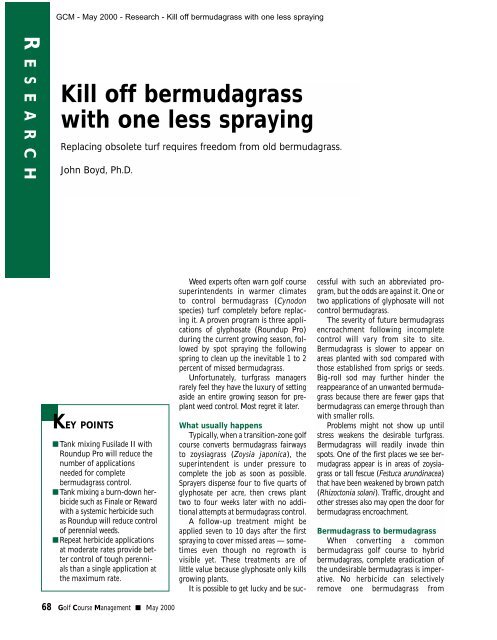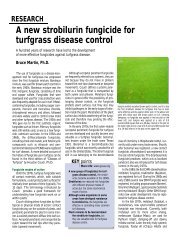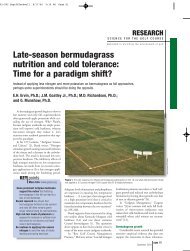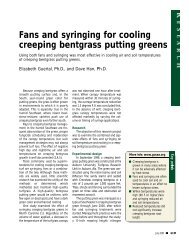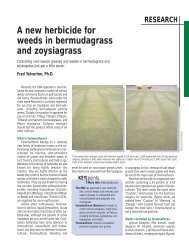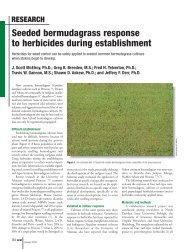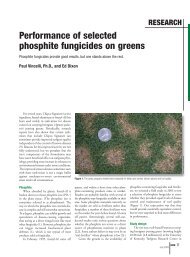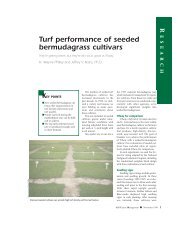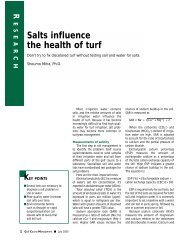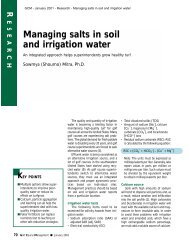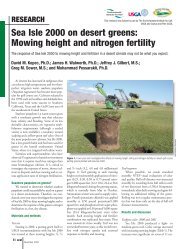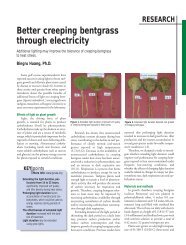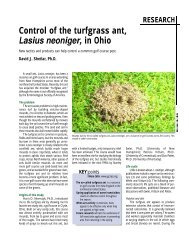Kill off bermudagrass with one less spraying - GCSAA
Kill off bermudagrass with one less spraying - GCSAA
Kill off bermudagrass with one less spraying - GCSAA
You also want an ePaper? Increase the reach of your titles
YUMPU automatically turns print PDFs into web optimized ePapers that Google loves.
GCM - May 2000 - Research - <strong>Kill</strong> <strong>off</strong> <strong>bermudagrass</strong> <strong>with</strong> <strong>one</strong> <strong>less</strong> <strong>spraying</strong>R E S E A R C H<strong>Kill</strong> <strong>off</strong> <strong>bermudagrass</strong><strong>with</strong> <strong>one</strong> <strong>less</strong> <strong>spraying</strong>Replacing obsolete turf requires freedom from old <strong>bermudagrass</strong>.John Boyd, Ph.D.KEY POINTS■ Tank mixing Fusilade II <strong>with</strong>Roundup Pro will reduce thenumber of applicationsneeded for complete<strong>bermudagrass</strong> control.■ Tank mixing a burn-down herbicidesuch as Finale or Reward<strong>with</strong> a systemic herbicide suchas Roundup will reduce controlof perennial weeds.■ Repeat herbicide applicationsat moderate rates provide bettercontrol of tough perennialsthan a single application atthe maximum rate.68 Golf Course Management ■ May 2000Weed experts often warn golf coursesuperintendents in warmer climatesto control <strong>bermudagrass</strong> (Cynodonspecies) turf completely before replacingit. A proven program is three applicationsof glyphosate (Roundup Pro)during the current growing season, followedby spot <strong>spraying</strong> the followingspring to clean up the inevitable 1 to 2percent of missed <strong>bermudagrass</strong>.Unfortunately, turfgrass managersrarely feel they have the luxury of settingaside an entire growing season for preplantweed control. Most regret it later.What usually happensTypically, when a transition-z<strong>one</strong> golfcourse converts <strong>bermudagrass</strong> fairwaysto zoysiagrass (Zoysia japonica), thesuperintendent is under pressure tocomplete the job as soon as possible.Sprayers dispense four to five quarts ofglyphosate per acre, then crews planttwo to four weeks later <strong>with</strong> no additionalattempts at <strong>bermudagrass</strong> control.A follow-up treatment might beapplied seven to 10 days after the first<strong>spraying</strong> to cover missed areas — sometimeseven though no regrowth isvisible yet. These treatments are oflittle value because glyphosate only killsgrowing plants.It is possible to get lucky and be suc-cessful <strong>with</strong> such an abbreviated program,but the odds are against it. One ortwo applications of glyphosate will notcontrol <strong>bermudagrass</strong>.The severity of future <strong>bermudagrass</strong>encroachment following incompletecontrol will vary from site to site.Bermudagrass is slower to appear onareas planted <strong>with</strong> sod compared <strong>with</strong>those established from sprigs or seeds.Big-roll sod may further hinder thereappearance of an unwanted <strong>bermudagrass</strong>because there are fewer gaps that<strong>bermudagrass</strong> can emerge through than<strong>with</strong> smaller rolls.Problems might not show up untilstress weakens the desirable turfgrass.Bermudagrass will readily invade thinspots. One of the first places we see <strong>bermudagrass</strong>appear is in areas of zoysiagrassor tall fescue (Festuca arundinacea)that have been weakened by brown patch(Rhizoctonia solani). Traffic, drought andother stresses also may open the door for<strong>bermudagrass</strong> encroachment.Bermudagrass to <strong>bermudagrass</strong>When converting a common<strong>bermudagrass</strong> golf course to hybrid<strong>bermudagrass</strong>, complete eradication ofthe undesirable <strong>bermudagrass</strong> is imperative.No herbicide can selectivelyremove <strong>one</strong> <strong>bermudagrass</strong> from
R E S E A R C HPhotos courtesy of John BoydJust two applications (top) of a mixture of Roundup Pro <strong>with</strong> Fusilade II were as effective atkilling <strong>bermudagrass</strong> as three applications of straight Roundup Pro (bottom).another. After establishment, all thatworks is mechanical removal and spot<strong>spraying</strong> <strong>with</strong> nonselective herbicides.Contamination from <strong>off</strong> the siteWhen buying sprigs or sod in<strong>bermudagrass</strong> country, inspect the farm.That is the best way to be reasonably surethat hybrid <strong>bermudagrass</strong>es are not contaminatedby <strong>off</strong>-types and that otherturfgrasses are free of <strong>bermudagrass</strong>.The best time to search a zoysiagrassfield for <strong>bermudagrass</strong> contaminationis in the early morning when <strong>bermudagrass</strong>patches are very obvious becausetheir leaves retain dew more readilythan zoysiagrass leaves do.Sod farmsManaging <strong>bermudagrass</strong> invasion isGolf Course Management ■ May 2000 69
R E S E A R C Hmore difficult on sod farms than on golfcourses. Sod harvest creates an idealopening for <strong>bermudagrass</strong> encroachment.The rapid regrowth of <strong>bermudagrass</strong>gives it an advantage against <strong>less</strong>aggressivespecies and allows it tospread before the desired grass coversthe open area. Many growers of zoysiagrassand centipedegrass have eliminated<strong>bermudagrass</strong> production fromtheir farms to reduce the potentialfor contamination.A common sight on sod farms,where pre-plant <strong>bermudagrass</strong> controlfailed, is a skirmish line of workersadvancing across a field armed <strong>with</strong>backpack sprayers. They are spot <strong>spraying</strong><strong>bermudagrass</strong> <strong>with</strong> glyphosate. Thedifficulty in achieving complete coverageand consistent follow-up applicationsunder these conditions makes thisa <strong>less</strong>-than-perfect method. Spot controlof <strong>bermudagrass</strong> is a job that rarelyends until the field is taken out of productionand cleaned up.Current recommendationsIn 1988, B.J. Johnson published thedefinitive research on preplant<strong>bermudagrass</strong> control. At Griffin, Ga.,Johnson demonstrated that three applicationsof Roundup Pro over a growingseason (May, June, August) wererequired for acceptable control of<strong>bermudagrass</strong>.After count<strong>less</strong> calls from golf coursesuperintendents and sod farmers, wesought enhancements to this approach.Generally following Johnson’s methods,we combined some grass-specific herbicides<strong>with</strong> glyphosate. Fusilade II (fluazifop-P-butyl)and Envoy (clethodim)Bermudagrass control9696■ 1 application■ 2 applications■ 3 applications70664615221712Various mixtures of Roundup <strong>with</strong> other herbicides provide very different results in the control of <strong>bermudagrass</strong>.70 Golf Course Management ■ May 2000
were selected based on past performancein <strong>bermudagrass</strong> controlstudies. We also included the nonselectiveherbicide Finale (glufosinate). Repeatapplications of the grass-specific herbicidesal<strong>one</strong> were not included because thebroadleaf and sedge control provided byRoundup is usually an important part ofturfgrass renovation programs.We initiated trials in May 1998 atsites about 50 miles apart in centralArkansas. One study was in a Tifwayhybrid <strong>bermudagrass</strong> field on a sodfarm. The other site used establishedplots of Tifway and Midlawn hybrid<strong>bermudagrass</strong> located at the Universityof Arkansas research station at Lonoke.The herbicide treatments at eachlocation were identical, but theapplication timings varied slightlybecause the research station plotsreceived irrigation, whereas the sod farmplots relied solely on rainfall. Follow-upherbicide applications were not madeuntil regrowth appeared.At the sod farm, applicationsoccurred a few days after significant rainfallsto coincide <strong>with</strong> favorable growingconditions. The trial was repeated in1999 on Tifway at the sod farm.The experimental design was a randomizedblock design. Plots were 6 feetby 10 feet <strong>with</strong> four replications.Herbicides were applied <strong>with</strong> a carbondioxide pressurized backpack sprayer.The carrier volume was 20 gallons peracre. Application dates at Lonoke in1998 were May, July and September. In1998, the spray dates at the sod farmwere May, July and October. Applicationtimings on the sod farm site in 1999were May, June and September.ResultsResults were straightforward andeasy to interpret. Only two treatmentsprovided acceptable control:• The standard recommendation ofthree applications of Roundup Pro at2 quarts of product per acre• Two applications of a herbicide combination:2 quarts of Roundup Proplus 24 fluid ounces Fusilade II productper acreThe results from these two treatmentswere consistent across the threetrials at <strong>one</strong> year after treatment.Compared <strong>with</strong> Roundup Pro al<strong>one</strong>,the tank mix <strong>with</strong> Fusilade II allowsturfgrass managers to achieve the samelevel of control <strong>with</strong> two applicationsrather than three.Glufosinate, a contact herbicide,mixed <strong>with</strong> glyphosate severely reduced<strong>bermudagrass</strong> control during bothyears across all locations. Apparently,the rapid tissue destruction caused byglufosinate prevented translocation ofRoundup Pro <strong>with</strong>in the plant, thereforereducing long-term control.Overall, herbicides applied in 1999were <strong>less</strong> effective than the same treatmentsapplied in 1998. The most logicalexplanation for the drop in control wasthe hot, dry conditions that persistedduring the summer of 1999.Our results support two basic tenetsof perennial weed control:• Tank mixing a fast-acting herbicidesuch as glufosinate <strong>with</strong> a slow-actingsystemic herbicide such as glyphosatewill reduce overall control. Threeapplications of Roundup Pro andFinale produced <strong>less</strong> than 50 percentcontrol in 1998 and 1999.• Repeat applications over time <strong>with</strong>postemergence, systemic herbicidesare superior to a single applicationusing the maximum label rate of theherbicide. We included a glyphosatetreatment at 10 quarts per acre in our1999 trials. Five months after <strong>spraying</strong>,a single 10-quart application wasproviding zero control compared <strong>with</strong>98 percent control for three applicationsat 2 quarts per acre.■References1. Johnson, B.J. 1988. Glyphosate and SC-0224for <strong>bermudagrass</strong> (Cynodon) cultivar control.Weed Technology 2:20-23.John Boyd, Ph.D., is a weed scientist <strong>with</strong> Universityof Arkansas division of agriculture’s CooperativeExtension Service.Golf Course Management ■ May 2000 71R E S E A R C H


